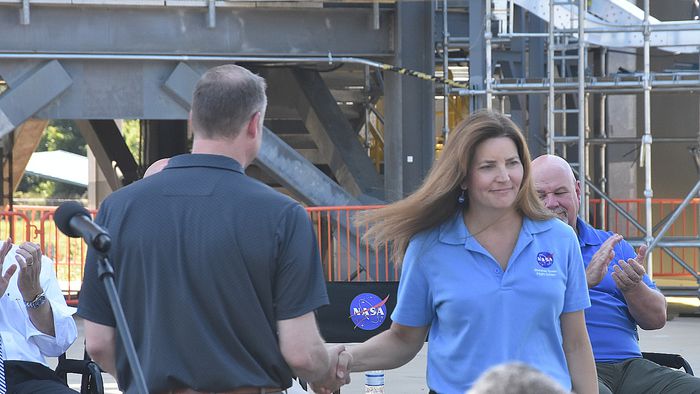
When the director of NASA’s Marshall Space Flight Center asked which of her managers might be interested in a big job in America’s return to the moon, Lisa Watson-Morgan said she looked around her office there.
Watson-Morgan’s father had been a graphic illustrator at Marshall in the 1960s around the time Wernher von Braun ran the center, and her father’s illustrations hang on her office walls today. One of those illustrations was a crew module.
“It just seemed like a natural fit and a wonderful opportunity,” Watson-Morgan said Friday moments after NASA Administrator Jim Bridenstine introduced her as leader of the team that will build the landers to put astronauts on the moon’s surface in 2024.
The landers have been a bit of a missing link in the Trump administration’s vision of returning quickly to the moon. NASA has been working on a rocket system capable of reaching both the moon and Mars, but the landers needed to get moving, too.
Employees across NASA have been working on some of the issues. Now, they are a formal team of 360 members, and they have a leader in Watson-Morgan.
If she feels the pressure of the job and the spotlight, Watson-Morgan didn’t show it Friday at Marshall when she was introduced to the world on NASA-TV. She smiled big as she shook Bridenstine’s hand in passing while heading to the podium.
She has the qualifications to feel confident. Watson-Morgan is a 30-year NASA veteran who earned a bachelor’s degree in industrial engineering from the University of Alabama in 1991 and followed that with a master’s degree in industrial and systems engineering in 1994 and a doctorate in engineering management in 2008, both from the University of Alabama in Huntsville.
She has received NASA’s top honors including a Meritorious Presidential Rank Award in 2018, Exceptional Achievement Medal in 2010 and the Exceptional Service Medal in 2001.
She and her husband have three children and live in Huntsville, which is her hometown. U.S. Rep. Mo Brooks, R-Huntsville, noted that Friday in praising her appointment.
“It’s poetic that the birthplace of America’s space program is also the birthplace of the project manager who is going to lead this effort…,” he said. “She was born in our community and went to Butler High School.
“She’s fully capable of taking on this project,” Brooks said.
NASA Administrator Jim Bridenstine agreed. Watson-Morgan has “risen through the ranks” and “has a lot of credibility with the highest people at NASA,” he said. “We’re very proud of her and the great work she does.”
That opinion is widely held. Eric Berger, a respected aerospace writer for the website ars technica, broke the news that Marshall had landed the lander program and Watson-Morgan would lead it. He called her “a senior engineer at the center who, according to sources in both Texas and Alabama, has an excellent reputation and is seen as a good manager. “
On her new job, Watson-Morgan will manage people working at several NASA centers on a job that she called Friday “a ferry system to take the crew back and forth.”
But her team will also test new technologies such as automated landing and navigation lidar (laser distance measuring). Astronauts will need those tools on Mars where they can’t come home quickly if there’s a problem.
There’s a lot to do and not much time to do it, but Watson-Morgan was excited about her mission. “We’re landing in a totally different place, and that’s really crucial,” she said. “The sun angles are totally different, so the landing is going to be totally different.”
She dismissed the argument of “been there-done that” about the moon mission with the wit and logic she’s becoming known for. “That’s like saying I’ve been to the Plains, so I don’t need to go to the Grand Canyon,” she said.
Watson-Morgan wants her team to “merge industry’s speed with NASA’s safety expertise to buy down risk.” The government workers will also keep “a vision in the eye of Mars, as well as the future” while the rest of the team “is trying to sprint to the moon.”
She’s also not worried about the competition between Marshall and the Johnson Space Flight Center in Houston for the leadership role. She pointed out that Johnson has the lead on getting astronauts off the moon when their mission is done.
“I have a lot of friends at the Johnson Space Center,” she said.

